
by Jonathan Benson
staff writer
September 30, 2011
from
NaturalNews Website
Since the initial release of the US Department of Agriculture's (USDA)
draft of organic standards in 1997, large industrial food processors have
been gradually acquiring or forming strategic alliances with organic food
brands.
And a series of detailed charts (far
below images) assembled by Philip H. Howard, an assistant professor at Michigan State University
(MSU),
provides a visual glimpse into how the organic industry has changed over the
years.
It was expected that, with the establishment of national organic standards
to replace the loose patchwork of state and local standards that existed
prior, large food producers would want in on the action. And many got what
they wanted, as they quickly gobbled up many of the largest and most viable
organic brands that existed at the time.
Howard explains that most acquisitions of organic brands by industrial food
processors occurred between 1997 and 2002, when USDA organic standards were
fully implemented.
During that time,
Other major acquisitions over the years include,
-
Kraft's takeover of Boca Foods and Back
to Nature
-
General Mills takeover of LaraBar and
Cascadian Farm
-
Pepsi's takeover of Naked Juice
And many other acquisitions have taken place
over the years as well, which you can learn more about at below charts.
Do these buyouts mean that the acquired brands are no longer reputable or of
the same quality as they were before? The answer to this, of course, is
dubious. In many cases, the contents of an acquired brand's products have
remained mostly or completely the same - the parent company simply wanted a
strategic piece of the pie.
But in other cases, the acquired brand's
offerings were altered to cut costs. Perhaps the most widely-known case of
brand tampering occurred with
Dean Foods Silk brand.
As many readers may already know,
Silk quietly stopped using organic soybeans in its soy milk products, but did not tell
customers. Silk even kept the same
barcodes and product packaging, which
resulted in some retailers unknowingly selling the altered product as if it
was organic for months after the change was made.
At the same time, many industrial food processed have developed organic
versions of their existing brands in response to growing consumer demand for
organic food, which has improved the overall quality of many popular brands.
These include for example, the introduction of,
Who Owns What in The Organic Industry
by Philip H. Howard
from
MichiganStateUniversity
Website
Organic Processing Industry Structure
The development of the USDA
National Organic Standard in place of differing
state/regional standards was widely predicted to accelerate trends of
increasing consolidation in this sector.
The first draft of the standard was released in
1997; what changes in ownership and control have since occurred?
2009 Organic Industry Structure
Top 30 Acquisitions
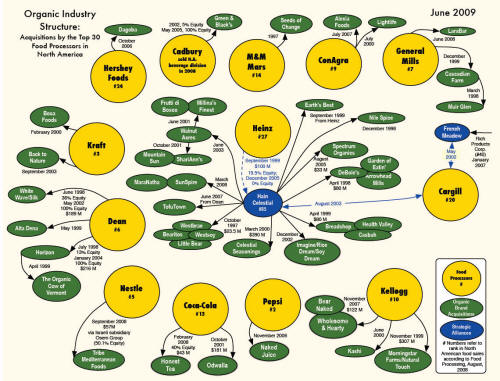
Changes since June 2009
include,
(1) Coca-Cola fully acquiring Honest Tea in March
2011
(2) Nestlé's acquisition of Sweet Leaf Tea in May,
2011
(3) Sara Lee's acquisition of Aidell's
Sausage for $87 million in May, 2011
Most acquisitions of organic processors occurred between
December, 1997 when the draft USDA standard was released,
and its full implementation in October, 2002. Few companies
identify these ownership ties on product labels.
Cargill's strategic alliances with French Meadow and Hain
Celestial are to develop products with nutritionally
enhanced organic ingredients such as phytosterols, soy
isoflavones, trehalose, inulin, and chondroitin.
Heinz acquired a 19.5%
stake in Hain Celestial in 1999 while also transferring
ownership of their Earth's Best brand, but sold all of its
Hain Celestial stock in 2005.
2008 Organic Industry Structure
Top 30 Acquisitions
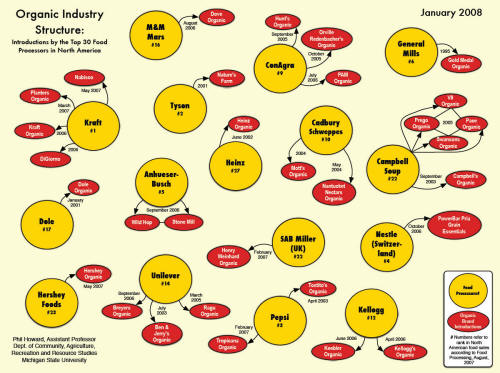
Most introductions of
organic versions of well-known brands occurred after the
USDA standard was implemented in October, 2002. Some, such
as Dove Organic, have been developed specifically for
Wal-Mart.
Organic Industry Structure
Significant Acquisitions and
Introductions
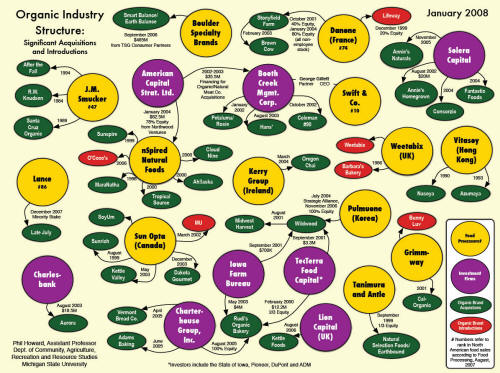
Venture capitalists
currently describe organic processing as "fragmented." They
are acquiring brands within the same sector (bread, meat,
etc.) with plans to sell them for significant gain at a
later date.
Organic Industry Structure
Major Independents and Their
Subsidiary Brands
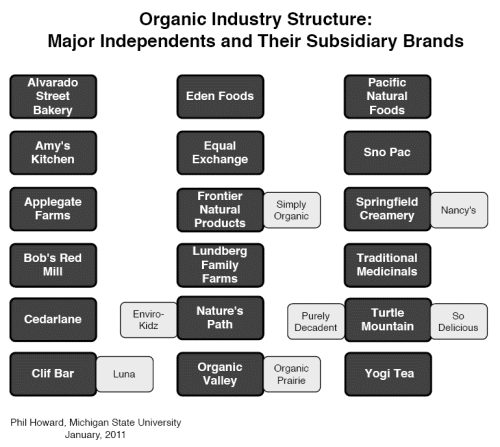
Most remaining
independent organic processors have resisted substantial
buyout offers
(typically 2 times
annual sales).
Organic Industry Structure
Private Label Brands
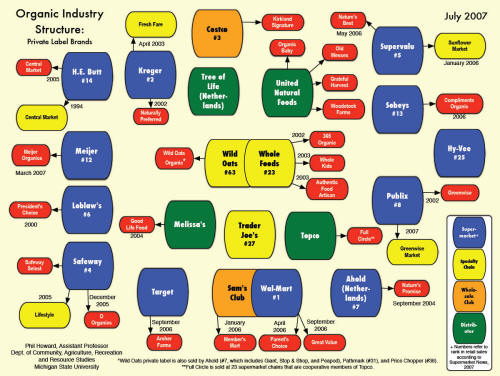
An increasing number of
supermarkets, wholesale clubs and distributors are
introducing organic private label products, in addition to
chains that specialize in organic and natural foods.





